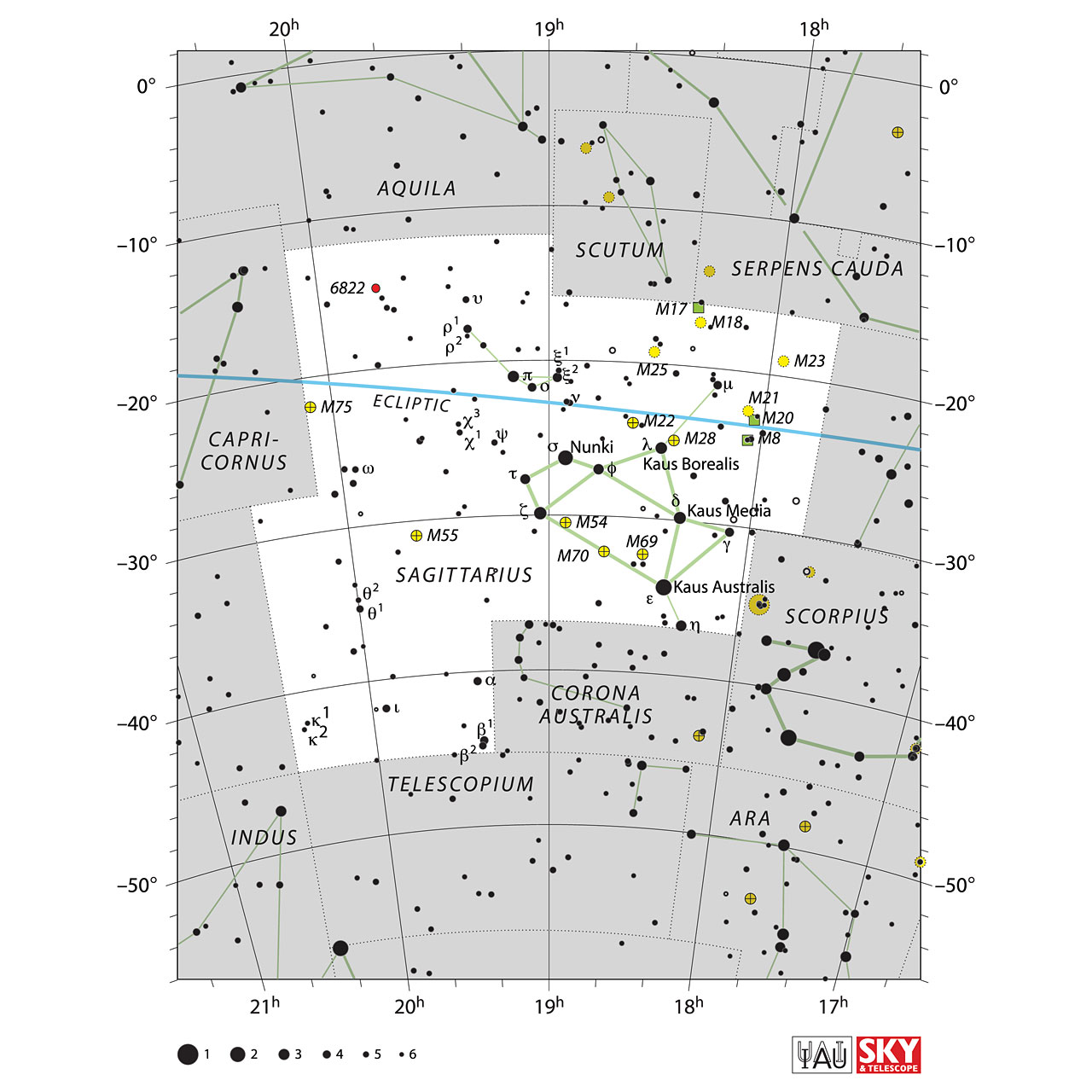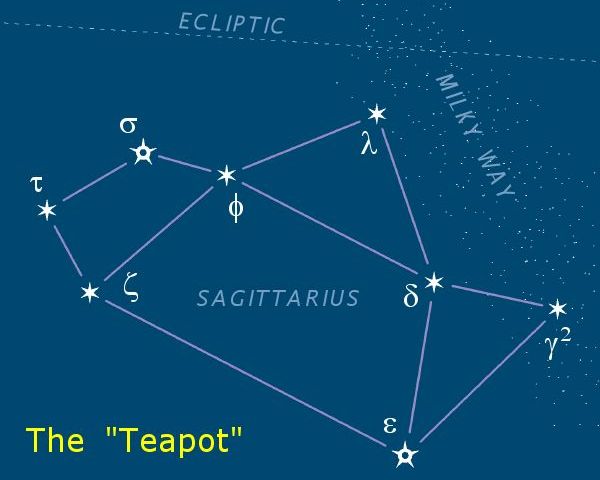Sagittarius


Sagittarius is a large southern constellation which spans the declination range δ=12°S to δ=45°S. It appears highest in the evening sky in the months around July.
This area of the sky looks directly towards the center of the Milky Way, which is marked by the radio source Sgr A. This makes it the richest of all the constellations for deep sky objects, including no fewer than fifteen open clusters and eighteen globular clusters brighter than tenth magnitude. Among these is M22, the fifth brightest globular cluster in the sky.
Sagittarius is spotted in the sky with an area of dense stars forming a Teapot (shown in image) asterism.

It is also home to the diffuse ninth-magnitude galaxy NGC 6822, also known as Caldwell 57.
Sagittarius is one of the twelve members of the zodiac, and the Sun passes through it each year between mid-December and mid-January.
Sagittarius is usually depicted as a centaur (half horse, half man) holding a bow and arrow. The constellation is of Sumerian origin and was subsequently adopted by the Greeks, leading to some uncertainty over the archer’s identity. According to Eratosthenes, the archer is Crotus, nurse to the Muses and the inventor of archery. However, this association is problematic as Crotus was not a centaur, but rather a satyr.
The constellation was placed in the night sky by Zeus to honor Chiron, the king of the centaurs. Chiron had galloped into a battle where some bad centaurs were attacking Hercules, and a good centaur, Pholus. Hercules was defending Pholus from the bad centaurs by shooting poison-tipped arrows at them. Not knowing that Chiron was there, Hercules shot one of his poison-tipped arrows at him by mistake and hit him. When Chiron fell to the ground, all of the other centaurs galloped away. Because he had been made immortal long before, Chiron did not die. He would have to live in horrible pain forever. Zeus took pity on him and ended Chiron’s great pain by allowing him to die.
Being one of the Zodiac cconstellations, Sagittarius is depicted using the symbol ![]() and with the emoji ♐.
and with the emoji ♐.
The Indian name for Sagittarius in Astronomy and Astrology is ಧನು (Dhanu).
Sagittarius contains:
-
Stars
- Kaus Australis (mag 1.8)
- Nunki (mag 2.1)
- Ascella (mag 2.6)
- Kaus Media (mag 2.7)
- Kaus Borealis (mag 2.8)
- π-Sgr (mag 2.9)
- Alnasl (mag 3.0)
- η-Sgr (mag 3.1)
- φ-Sgr (mag 3.1)
- τ-Sgr (mag 3.3)
- ξ²-Sgr (mag 3.5)
- O-Sgr (mag 3.8)
- μ-Sgr (mag 3.8)
- ρ¹-Sgr (mag 3.9)
- Rukbat (mag 3.9)
- Arkab Prior (mag 3.9)
- ι-Sgr (mag 4.1)
- Arkab Posterior (mag 4.3)
- θ¹-Sgr (mag 4.3)
- V3872 Sgr (mag 4.5)
- b¹-Sgr (mag 4.5)
- HD 165634 (mag 4.6)
- υ-Sgr (mag 4.6)
- X Sgr (mag 4.6)
- h²-Sgr (mag 4.6)
-
Open Clusters
- NGC 6530 (mag 4.6)
- Messier 25 (mag 4.6)
- Messier 23 (mag 5.5)
- Messier 21 (mag 5.9)
- Messier 17 (mag 6.0)
- Messier 20 (mag 6.3)
- Messier 18 (mag 6.9)
- NGC 6595 (mag 7.0)
- NGC 6716 (mag 7.5)
- NGC 6520 (mag 7.6)
- NGC 6647 (mag 8.0)
- NGC 6546 (mag 8.0)
- NGC 6469 (mag 8.2)
- NGC 6645 (mag 8.5)
- NGC 6568 (mag 8.6)
- NGC 6507 (mag 9.6)
- NGC 6583 (mag 10.0)
- NGC 6603 (mag 11.1)
- NGC 6540 (mag 14.6)
- NGC 6774
- NGC 6737
- NGC 6596
- NGC 6561
-
Globular Clusters
- Messier 22 (mag 5.2)
- Messier 55 (mag 6.3)
- NGC 6723 (mag 6.8)
- Messier 28 (mag 6.9)
- NGC 6544 (mag 7.5)
- NGC 6624 (mag 7.6)
- Messier 54 (mag 7.7)
- Messier 70 (mag 7.8)
- NGC 6553 (mag 8.3)
- Messier 69 (mag 8.3)
- NGC 6717 (mag 8.4)
- NGC 6569 (mag 8.4)
- NGC 6652 (mag 8.5)
- NGC 6558 (mag 8.6)
- Messier 75 (mag 8.6)
- NGC 6642 (mag 8.9)
- NGC 6522 (mag 9.5)
- NGC 6638 (mag 9.7)
- NGC 6440 (mag 10.1)
- NGC 6528 (mag 10.7)
-
Galaxy
- NGC 6822 (mag 9.3)
- IC 4991 (mag 12.3)
- NGC 6878 (mag 12.4)
- NGC 6835 (mag 12.5)
- IC 4931 (mag 12.8)
- NGC 6836 (mag 13.0)
- NGC 6841 (mag 13.4)
- NGC 6902 (mag 13.6)
- NGC 6806 (mag 13.8)
- NGC 6794 (mag 13.9)
- IC 4913 (mag 14.0)
- IC 4998 (mag 14.0)
- NGC 6890 (mag 14.0)
- NGC 6805 (mag 14.3)
- IC 1309 (mag 15.2)
- IC 5018
- IC 4895
View Sagittarius in 3D 
Source: Wikipedia, in-the-sky.org
Image Courtesy: Sky&Telescope & IAU, Illustration Images linked from Urania's Mirror on Wikmedia Commons by Sidney Hall
Image Courtesy: Sky&Telescope & IAU, Illustration Images linked from Urania's Mirror on Wikmedia Commons by Sidney Hall
